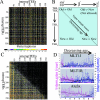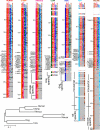Evolutionary history of mammalian transposons determined by genome-wide defragmentation
- PMID: 17630829
- PMCID: PMC1914374
- DOI: 10.1371/journal.pcbi.0030137
Evolutionary history of mammalian transposons determined by genome-wide defragmentation
Abstract
The constant bombardment of mammalian genomes by transposable elements (TEs) has resulted in TEs comprising at least 45% of the human genome. Because of their great age and abundance, TEs are important in comparative phylogenomics. However, estimates of TE age were previously based on divergence from derived consensus sequences or phylogenetic analysis, which can be unreliable, especially for older more diverged elements. Therefore, a novel genome-wide analysis of TE organization and fragmentation was performed to estimate TE age independently of sequence composition and divergence or the assumption of a constant molecular clock. Analysis of TEs in the human genome revealed approximately 600,000 examples where TEs have transposed into and fragmented other TEs, covering >40% of all TEs or approximately 542 Mbp of genomic sequence. The relative age of these TEs over evolutionary time is implicit in their organization, because newer TEs have necessarily transposed into older TEs that were already present. A matrix of the number of times that each TE has transposed into every other TE was constructed, and a novel objective function was developed that derived the chronological order and relative ages of human TEs spanning >100 million years. This method has been used to infer the relative ages across all four major TE classes, including the oldest, most diverged elements. Analysis of DNA transposons over the history of the human genome has revealed the early activity of some MER2 transposons, and the relatively recent activity of MER1 transposons during primate lineages. The TEs from six additional mammalian genomes were defragmented and analyzed. Pairwise comparison of the independent chronological orders of TEs in these mammalian genomes revealed species phylogeny, the fact that transposons shared between genomes are older than species-specific transposons, and a subset of TEs that were potentially active during periods of speciation.
Conflict of interest statement
Figures





Similar articles
-
Species-specific chromatin landscape determines how transposable elements shape genome evolution.Elife. 2022 Aug 23;11:e81567. doi: 10.7554/eLife.81567. Elife. 2022. PMID: 35997258 Free PMC article.
-
The evolutionary history of human DNA transposons: evidence for intense activity in the primate lineage.Genome Res. 2007 Apr;17(4):422-32. doi: 10.1101/gr.5826307. Epub 2007 Mar 5. Genome Res. 2007. PMID: 17339369 Free PMC article.
-
Mammalian transposable elements and their impacts on genome evolution.Chromosome Res. 2018 Mar;26(1-2):25-43. doi: 10.1007/s10577-017-9570-z. Epub 2018 Feb 1. Chromosome Res. 2018. PMID: 29392473 Free PMC article. Review.
-
Massive contribution of transposable elements to mammalian regulatory sequences.Semin Cell Dev Biol. 2016 Sep;57:51-56. doi: 10.1016/j.semcdb.2016.05.004. Epub 2016 May 10. Semin Cell Dev Biol. 2016. PMID: 27174439 Review.
-
Comparative analysis of transposable elements highlights mobilome diversity and evolution in vertebrates.Genome Biol Evol. 2015 Jan 9;7(2):567-80. doi: 10.1093/gbe/evv005. Genome Biol Evol. 2015. PMID: 25577199 Free PMC article.
Cited by
-
29 mammalian genomes reveal novel exaptations of mobile elements for likely regulatory functions in the human genome.PLoS One. 2012;7(8):e43128. doi: 10.1371/journal.pone.0043128. Epub 2012 Aug 27. PLoS One. 2012. PMID: 22952639 Free PMC article.
-
(Meta)genomic insights into the pathogenome of Cellulosimicrobium cellulans.Sci Rep. 2016 May 6;6:25527. doi: 10.1038/srep25527. Sci Rep. 2016. PMID: 27151933 Free PMC article.
-
ZNF146/OZF and ZNF507 target LINE-1 sequences.G3 (Bethesda). 2022 Mar 4;12(3):jkac002. doi: 10.1093/g3journal/jkac002. G3 (Bethesda). 2022. PMID: 35100360 Free PMC article.
-
Intergenic and repeat transcription in human, chimpanzee and macaque brains measured by RNA-Seq.PLoS Comput Biol. 2010 Jul 1;6(7):e1000843. doi: 10.1371/journal.pcbi.1000843. PLoS Comput Biol. 2010. PMID: 20617162 Free PMC article.
-
The mutational spectrum of non-CpG DNA varies with CpG content.Genome Res. 2010 Jul;20(7):875-82. doi: 10.1101/gr.103283.109. Epub 2010 May 24. Genome Res. 2010. PMID: 20498119 Free PMC article.
References
-
- Prak ET, Kazazian HH., Jr Mobile elements and the human genome. Nat Rev Genet. 2000;1:134–144. - PubMed
-
- Eichler EE, Sankoff D. Structural dynamics of eukaryotic chromosome evolution. Science. 2003;301:793–797. - PubMed
-
- Lander ES, Linton LM, Birren B, Nusbaum C, Zody MC, et al. Initial sequencing and analysis of the human genome. Nature. 2001;409:860–921. - PubMed
-
- Kazazian HH., Jr Mobile elements: Drivers of genome evolution. Science. 2004;303:1626–1632. - PubMed
Publication types
MeSH terms
Substances
Grants and funding
LinkOut - more resources
Full Text Sources
Other Literature Sources
Miscellaneous

